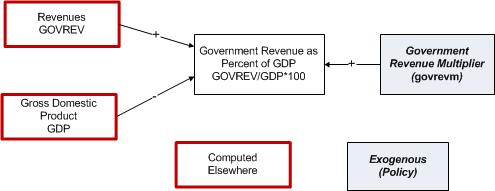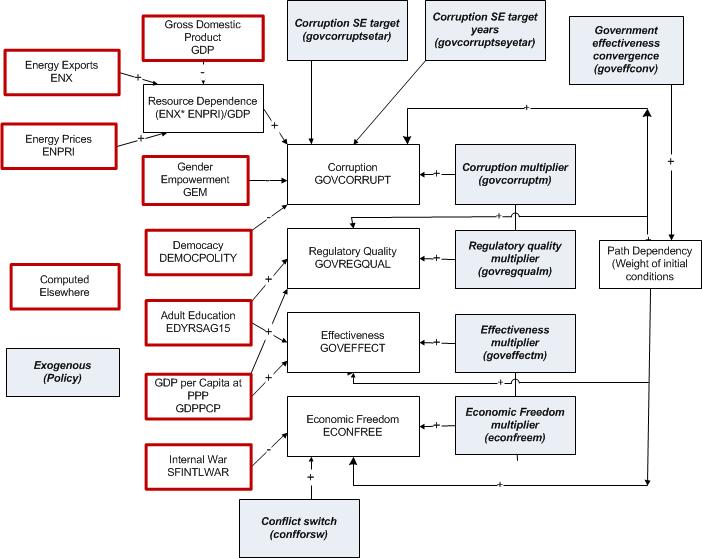International Futures Help System
Capacity
Government Revenues
The ability to raise government revenues (GOVREV as a share of GDP) is one of the dimensions of capacity in governance. Its basic calculation is a very simple ratio. The key drivers of GOVREV, however, documented elsewhere, are very complex. For instance, GOVREV is responsive in an equilibration process to government expenditures, both transfer payments and direct government expenditures in categories such as military, health, education, and infrastructure, as well as to external revenues, notably foreign aid receipts.

Effectiveness of Government
The central measure of governance effectiveness in Hughes et al. (2014) was defined to be corruption or GOVCORRUPT (actually the absence thereof, or level of transparency). The model computes several additional measures of effectiveness or capacity, however, including regulatory quality (REGQUALITY) and effectiveness (GOVEFFECT), both related to the World Bank's World Governance Indicator project (Kaufmann, Kraay, and Mastruzzi 2010). In addition, many analysts point to the level of economic freedom (ECONFREE) or liberalization as a measure of effectiveness, in spite of considerable debate around their doing so.
Among the drivers of governance corruption is resource dependence, for which we use as a proxy the value of energy exports (ENX) at energy prices (ENPRI) as a share of GDP. Energy exports tend to me the largest such category globally. Further drivers are the extent of gender empowerment (GEM) and the level of democracy (DEMOCPOLITY), both of which indicate the extent of inclusiveness but which make independent statistical contributions to corruption level.
The drivers do not, of course, fully determine the level of corruption and there is much historical path dependence in societies related to other variables. The user can control the speed of elimination of such dependence and therefore of convergence to the basic formulation with a conversion years parameter ( goveffconv ).

There are times when the user will wish to introduce normatively controlled target values for corruption. One approach is use of the "brute force" multiplier on corruption ( govcorruptm ). A second approach involves the specification of target values relative to a function of the key drivers estimated cross-sectionally across countries. This second approach allows, for instance, the specification of a target level 1 or 2 standard errors (SE) above the level expected of a country given those drivers. The SE target parameter is govcorruptsetar and the govcorruptseyrtar carries the years to achieve the target. There are similar control parameters (not shown the diagram) for regulatory quality ( govregqualsetar and govreqqualseyrtar ) and for effectiveness ( goveffectsetar and goveffectseyrtar ), but not for economic freedom.
Theoretically, internal war (SFINTLWAR) could affect all of the capacity variables, but the only linkage identified in IFs is that to economic freedom. Setting the control switch ( confforsw ) to 1 turns on that impact.
 International Futures at the Pardee Center
International Futures at the Pardee Center